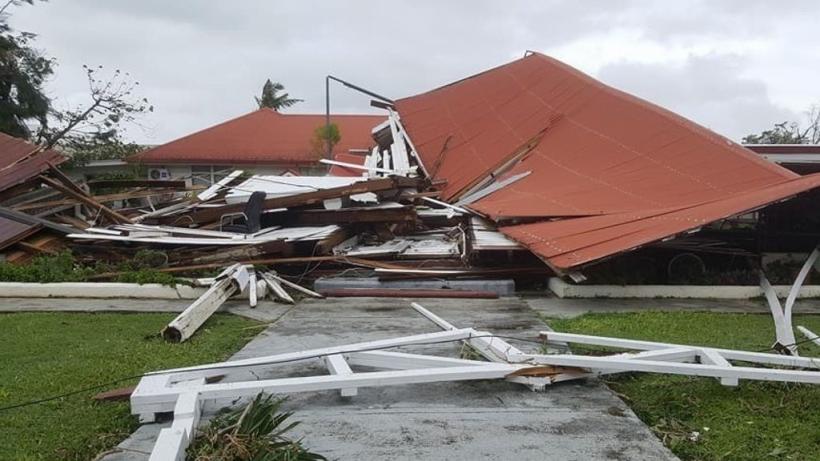BUILDING DISASTER RESILIENCE IN THE PACIFIC THROUGH CONTINGENT FINANCING

Overview
A number of countries in the Pacific are exploring innovative measures to build resilience against disasters. In December 2017, the Asian Development Bank (ADB) approved the Pacific Disaster Resilience Program. The program provides a predictable and quick-disbursing source of financing for early response and recovery activities following disaster events, through policy-based operations, and supports priority actions in disaster risk management (DRM) in Samoa, Tonga and Tuvalu.
The program applies a regional approach to addressing disaster risk and supports collaboration among the participating countries to strengthen disaster risk financing. An attached technical assistance is supporting DRM in participating countries and assessing options for setting up a collaborative regional mechanism to channel disaster contingent financing. A regional mechanism would allow funds to be replenished, additional countries to join, and other donors to contribute to the contingent funds.
Disaster risk in the Pacific
Pacific economies are highly exposed to a range of natural hazards including tropical cyclones, floods, storm surges, droughts, earthquakes, tsunamis, and volcanic eruptions. The subregion also experiences a disproportionately high share of global disaster impacts relative to its demographic and economic size.
No single financing instrument is suited for responding to all types of disasters, which range from frequent, small-scale events to rare catastrophic events. A layered approach to disaster risk financing, through a range of tools within a common framework to address different layers of risk, is the most cost-effective means toward comprehensive financing of disaster response. Contingent financing is particularly cost-effective in addressing medium-layer risks, that involve events that would exhaust annual contingency budgets and reserves but may be too frequent to be covered cost-effectively through insurance.
The Pacific Disaster Resilience Program
Building on the experience in the Cook Islands in 2016, the Pacific Disaster Resilience Program includes policy matrices that support the development of effective and comprehensive DRM strategies and programs at the country level, and disaster resilience-related policy actions. These policy actions strengthen the resilience of institutions and communities in the participating Pacific economies. Samoa, Tonga, and Tuvalu face similar DRM challenges and therefore benefit from a regional approach under which good practices are shared.
In the event of a declared disaster, respective governments can withdraw their allocations partially or entirely, depending on its assessment of the disaster’s severity and resultant need. The program complements existing disaster risk financing instruments available to participating Pacific economies, but with unique features including: (i) it can make a payment quickly and use the funds flexibly with no additional requirements, beyond national public financial management requirements, to track and report on expenditures; (ii) the amount that can be released is significant in terms of immediate response needs; (iii) the amount is not dependent on any assessment of loss or measure of the intensity of the natural hazard; and (iv) funds are available for disaster events triggered by any type of natural hazard.
Immediate proof-of-concept: Cyclone Gita
On 12 February 2018, Cyclone Gita hit Tonga’s main island of Tongatapu and neighboring ‘Eua island with sustained winds of up to 145 miles per hour. The cyclone damaged homes, government buildings, and infrastructure for basic services, including water supply, sanitation and waste management, electricity, and communications. The total value of effects caused by the cyclone were estimated to be approximately $164 million, equivalent to about 38% of the nominal 2017 gross domestic product in Tonga.
The Pacific Disaster Resilience Program allowed ADB to provide $6 million within a few days of Gita’s impact, to supplement Tonga’s available financial resources to fund critical early response and recovery activities. This marked the first time that ADB provided post-disaster funds through contingent financing, allowing government to respond quickly to emerging needs. Recognizing clear benefits from the program, the Government of Tonga has requested for replenishment of their line of contingent finance.
Moving forward
Given the demonstrated value of the contingent financing approach, ADB is exploring further expanding the coverage to include other Pacific economies under a second phase of the program. The Pacific Disaster Resilience Program includes technical assistance work to not only support and monitor progress toward achieving the governments’ long-term DRM goals, but also explore options for regional collaboration around contingent financing and a potential permanent regional contingent savings mechanism. These and other new and innovative approaches to ensure the immediate availability of adequate disaster financing will be important in building the Pacific’s overall resilience against the rising disaster risks.
*Image: The Tonga parliament house in the capital Nuku’alofa after the destruction brought by Cyclone Gita. ADB’s Pacific Disaster Resilience Program provided $6 million within 24 hours from receiving the Government’s withdrawal request, to help fund priority early recovery activities in the country. Photo by ADB.
This blog post is written by Hanna Uusimaa, Climate Change Specialist at Asian Development Bank (ADB).